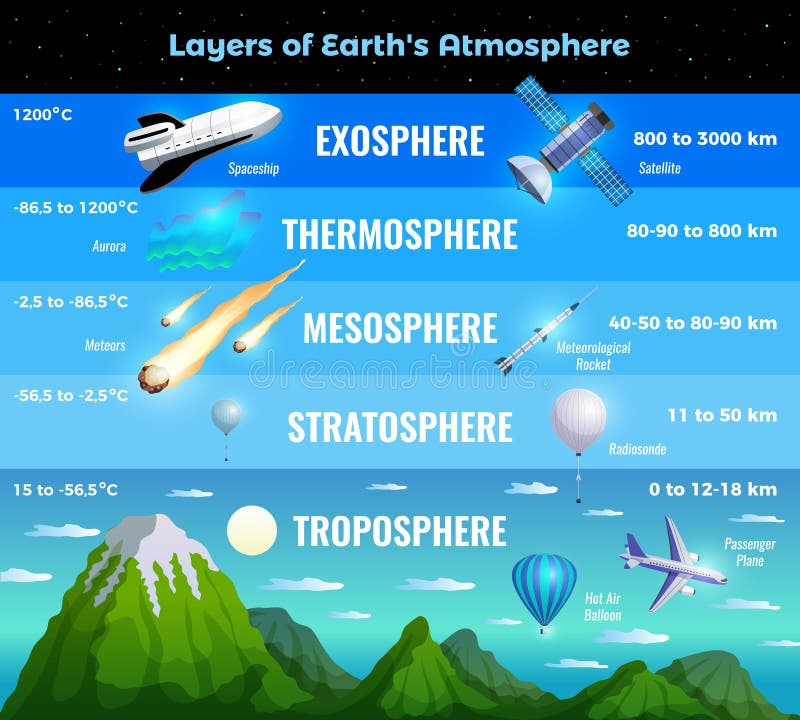Happy Monday, 6th graders!
Today we move into a new topic: weather and climate!
Let's start with an exploration of Earth’s atmosphere because without an atmosphere, there would be no weather.
Directions: Use the diagrams, reading, or videos to help you write 2-3 facts about each layer of Earth's atmosphere.
You may click here and print this note-catcher or create your own.
Please send a picture of your completed note-catcher to Ms. Dolan: adolan@hccs481.org ms.dolans_science
 |
|
Information extracted from IPTC Photo Metadata.
|
 |
| https://scied.ucar.edu/atmosphere-layers |
Layers of Earth’s Atmosphere
Earth’s atmosphere has five layers, each with its own characteristics. Moving upward from ground level, these layers are named the troposphere, stratosphere, mesosphere, thermosphere and exosphere. The exosphere gradually fades away into the realm of interplanetary space.
Troposphere
The troposphere is the lowest layer of our atmosphere. Starting at ground level, it extends upward to about 10 km (6.2 miles or about 33,000 feet) above sea level. We humans live in the troposphere, and nearly all weather occurs in this lowest layer. Most clouds appear here, mainly because 99% of the water vapor in the atmosphere is found in the troposphere. Air pressure drops, and temperatures get colder, as you climb higher in the troposphere.
Stratosphere
The next layer up is called the stratosphere. The stratosphere extends from the top of the troposphere to about 50 km (31 miles) above the ground. The infamous ozone layer is found within the stratosphere. Ozone molecules in this layer absorb high-energy ultraviolet (UV) light from the Sun, converting the UV energy into heat. This protects us from the dangers of UV radiation- without the stratosphere’s protection the UV rays could harm us!
Unlike the troposphere, the stratosphere actually gets warmer the higher you go! Commercial passenger jets fly in the lower stratosphere, partly because this less-turbulent layer provides a smoother ride. The jet stream flows near the border between the troposphere and the stratosphere.
Mesosphere
Above the stratosphere is the mesosphere. It extends upward to a height of about 85 km (53 miles) above our planet. Most meteors burn up in the mesosphere. Unlike the stratosphere, temperatures once again grow colder as you rise up through the mesosphere. The coldest temperatures in Earth’s atmosphere, about -90° C (-130° F), are found near the top of this layer. The air in the mesosphere is far too thin to breathe; air pressure at the bottom of the layer is well below 1% of the pressure at sea level, and continues dropping as you go higher.
Thermosphere
The layer of very thin air above the mesosphere is called the thermosphere. High-energy X-rays and UV radiation from the Sun are absorbed in the thermosphere, raising its temperature to hundreds or at times thousands of degrees. However, the air in this layer is so thin that it would feel freezing cold to us! In many ways, the thermosphere is more like outer space than a part of the atmosphere. Many satellites actually orbit Earth within the thermosphere! The aurora, the Northern Lights and Southern Lights, occur in the thermosphere.
Exosphere
Although some experts consider the thermosphere to be the uppermost layer of our atmosphere, others consider the exosphere to be the actual “final frontier” of Earth’s atmosphere. As you might imagine, the “air” in the exosphere is very, very, very thin, making this layer even more space-like than the thermosphere. In fact, air in the exosphere is constantly – though very gradually – “leaking” out of Earth’s atmosphere into outer space. There is no clear-cut upper boundary where the exosphere finally fades away into space. Different definitions place the top of the exosphere somewhere between 100,000 km (62,000 miles) and 190,000 km (120,000 miles) above the surface of Earth. That means the exosphere ends halfway to the Moon!
Sky-Diving from the Stratosphere
In October 2012, an Austrian skydiver named Felix Baumgartner, took a small, balloon-powered capsule 24 miles above Earth's surface into the Stratosphere (Earth's 2nd atmosphere layer). Then he jumped! He was in free-fall for several minutes and actually went supersonic, which means his body was moving as fast as the speed of sound. At its fastest, his body was falling over 800 miles per hour! The video below shows this record-breaking jump.
As you watch, be sure to notice what Earth and sky look like from the stratosphere (it kind of looks like space) and remember that there are more layers of atmosphere above him!
No comments:
Post a Comment